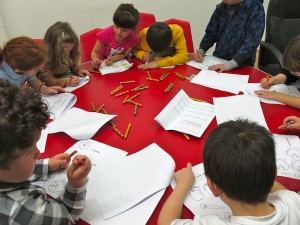Christina Prostano’s great-grandparents immigrated to America from Italy in the early 20th century, but her family’s ability to speak Italian disappeared over the generations.
Prostano mourned that loss and wanted her children, Amelia, now 4, and Anna, now 2, to learn Italian even though she herself only knew a few words of the language.
When Amelia was 18 months old, she hired Italian au pairs for her daughters, who now understand the language well. But school remained a barrier. Though her daughters could take private Italian classes, there wasn’t an Italian-English dual-language program in the city’s public schools. “What am I going to do, have them taught for one hour a week, and hope that they learn the language?” she said.
She’s now trying to fill that void, starting with a Facebook page and survey to measure interest, which has attracted about 70 families – both English and Italian-speaking. But Prostano still needs to find a school that has the desire and means to start the program, support and funding from Italian organizations, and qualified teachers.

Most of New York City’s 79 dual-language programs are Spanish, according to the city’s Department of Education June 2011 Bilingual Education Student Information Survey (this list excludes charter schools). But recently other languages have been added, including French and Chinese, currently each in six schools, and one in Korean. The city didn’t have any French dual-language programs until around five years ago. In 2007, the first three opened, including one at P.S. 58 in Carroll Gardens, and in 2011, French dual-language schools opened at P.S. 133 in Park Slope and P.S.110 in Greenpoint.
P.S. 133 is adding a Spanish dual-language program in the fall, and may add a second kindergarten French dual-language class, said Kevin Goetz, who teaches the French immersion kindergarten class at the school.
The boom in French dual-language programs, particularly in Brooklyn, gives Prostano hope for an Italian one.
According to U.S. Census data, in 2010, 95,342 people in Brooklyn five years or older spoke Italian at home, and 78,322 spoke French.
In addition to native speakers, there are also many Italian-Americans in New York City, especially in certain sections of Brooklyn, such as Bay Ridge and Carroll Gardens, said Prostano. And like her, many want to preserve their culture.
In Brooklyn, two private language schools, Hands on World and Little Language Playhouse, offer Italian programs for young children, but not full-time immersion. P.S. 110 in Greenpoint has 50-minute Italian classes once to twice a week for students from kindergarten to fifth grade, but only a dual-language program in French.
To gauge interest in a full-day Italian program in elementary schools, Prostano set up a survey and Facebook group, Italian Families NYC, on Feb. 29.
“Within two days, I had 30 responses to the survey, which is pretty fantastic,” she said. Out of the around 70 families who have taken it, more than 50 percent have at least one parent who is an Italian native speaker, and 25 percent have two parents. The survey also showed balanced interest from native English and native Italian speakers, and of boys and girls, which is required for any dual-language program, Prostano said.
But interest isn’t enough. French dual-language programs have the support from the French Embassy and other similar institutions.
In 2005, French parents formed an organization, Education Française à New York, to find French-language alternatives to the city’s private schools, said the French Embassy’s education attaché, Fabrice Jaumont. It was a parent-led initiative, he said, but support and funding from French government institutions helped create dual programs in the city’s public schools.
Prostano has recently spoken with the Italian American Committee on Education, a nonprofit organization that promotes the study of the Italian language and culture in New York, New Jersey and Connecticut. Licia Tonetto, assistant manager of the committee, said it offers grants to schools for Italian language classes — up to $25,000 for teacher’s salaries and $8,000 for materials, said Tonetto. The organization also gave Prostano information to contact the Italian Consulate, which can help her find funding from other Italian-American groups.
Having a school that is committed to an Italian dual-language program will help with getting those grants, and Prostano is currently approaching several schools.
Prostano said she may have better success with a school that has an existing dual-language program. But it’s also important to find a school easily accessible to the interested families, she said. According to her survey, most live in Districts 14 (Williamsburg and Greenpoint) and 15 (Carroll Gardens, Red Hook, Windsor Terrace and parts of Park Slope, Boerum Hill and Fort Greene).
P.S. 133 in Park Slope (District 13) is a good candidate because it has a new school building under construction, she said (this building may also serve the nearby District 15). She has yet to hear from that school, but she has spoken with P.S. 110 in District 14. Prostano is also exploring creating Italian classes similar to the ones at P.S. 110.
The principal of P.S. 110, Anna Cano Amato, said the school started the Italian classes in 2010 because parents wanted their children to study a foreign language — no matter which one — and the school had a native Italian teacher on staff already. Amato is open to an Italian dual-language program, but would like to see Prostano’s group have some more backing and sources of funding. Also, P.S. 110’s Italian teacher isn’t certified to teach a dual-language program.
It’s difficult to find a teacher with the language skills and proper certification. On top of an early childhood education certification to teach elementary school, a dual-language teacher needs a bilingual extension certificate from the New York State Education Department, says Anne Ebe, a professor at the Hunter College School of Education.
This fall may be too early for an Italian dual-language program in New York City’s public schools, but Prostano hopes to have one in place when her daughter enters kindergarten in 2013.


